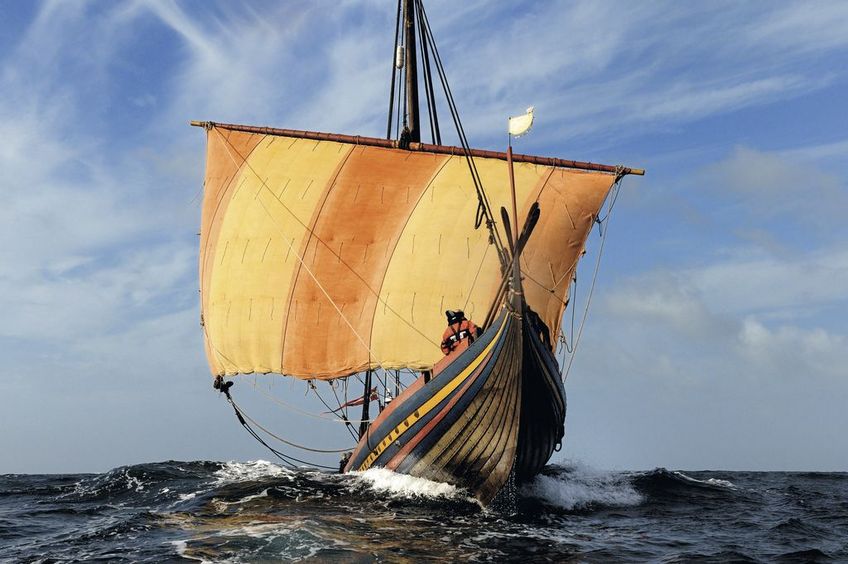
The Sea Stallion from Glendaloug (Skuldelev 2)
Between August 2000 and September 2004 the Viking Ship Museum built a full-scale reconstruction of the Skuldelev 2 ship. The construction, which took place in the boatyard, is part of a research and communication project, the aims of which include increasing knowledge of Viking Age longships, materials, tools, construction processes, sails and rigging – and creating greater public consciousness concerning this aspect of our cultural heritage. The project is also attempting to shed light on a series of cultural-historical questions concerning the relationship between the Viking longships and contemporary society. The project was financed by way of a donation of 10 million Danish crowns (ca 1,340,000 Euro) from the Tuborg Foundation.
The Skuldelev 2 ship is a 30m-long sea-going warship; a 30-seater with 60 oars and room for a crew of 80 men. It is a compact and sturdily built vessel, characterised by similarly compact partitioning modules with closely-spaced frames (floor timbers), cross-beams and thwarts together with a sharp bottom with upright garboard. It is the least well preserved of the five Skuldelev ships. The ca. 25 % that remained – a total of 1800 ship components – includes, however, the most important parts needed to establish the ship’s original dimensions. Significant parts of the bottom of the hull with floor timbers, knees and longitudinal reinforcements, keelson and after-stem, along with the section of planking towards the stern up to the sheer line, are preserved together with a number of details revealing the construction of the side of the hull in the rowing area, the hood ends at the stem, location of the aftermost thwart etc. As a result, it has been possible to produce a satisfactory reconstruction.
A Nordic collaboration
15-20 boat builders from Denmark, the Faroe Islands, Norway and the Åland Islands have been involved in the project. It has taken 27,000 man hours – distributed over four years – to build the ship itself. If it were to be built as quickly as possible it could, according to our preliminary calculations, be built in seven months by a master builder, ten boat builders and a large workforce in the forest. When time for tar production, blacksmithing, rope-making, sail-making etc. is included, approximately 40,000 hours were spent on the manufacture of ship, sail and rigging.
150 cubic metres of wood were used for the ship. To this can be added the 18 cubic metres of pinewood used to produce tar as well as 4,500 one-metre-long, arm-thick lime branches stripped for bast along with large quantities of charcoal and bog iron ore to produce about 400 kg of raw iron, 600 horsetails for ropes etc. The provisional sail is made of cotton; it would have required 200 kg of processed flax or wool to manufacture a sail in the original materials.
The ship had an impressive rigging. The 13 m long keelson and the many keelson knees illustrate the ship’s advanced technical level and daring construction. Everything is minimised in dimension and weight without weakening the strength of the construction. Calculations of the ship’s hull-rigging-rudder balance formed the basis for the construction of the 14.5 m high mast, a 12 m long yard and a square sail of 112 m2.
The reconstruction was named ‘Havhingsten fra Glendalough’ (The seastallion from Glendalough in Ireland) and launched on the 4th September 2004.
The ship was on a sea trial from Roskilde to Dublin in 2007 and from Dublin to Roskilde in 2008.
References
Larsen, Anne-Christine et al (red.) 2008: Havhingsten fra Glendalough/The Sea Stallion from Glendalough Roskilde-Dublin 2007. En forsøgsrejse i billeder/Pictures of a trial voyage. Med fotos af/With photos by Werner Karrasch. Roskilde.
Bill, Jan, Søren Nielsen, Erik Andersen & Tinna Damgård-Sørensen 2007: Velkommen ombord! Havhingsten fra Glendalough. Et genskabt langskib fra vikingetiden. Roskilde.
Bill, Jan, Søren Nielsen, Erik Andersen & Tinna Damgård-Sørensen 2007:Welcome on board! The Sea Stallion from Glendalough. A Viking longship recreated. Roskilde.
Damgård-Sørensen, Tinna, Søren Nielsen & Erik Andersen 2004: Fuldblod på havet. In: Lund, Niels (ed.) Toogtyvende tværfaglige Vikingesymposium 2003. Højbjerg, 5-50.
Nielsen, Søren 2002: Langskibet undervejs. Marinarkæologisk Nyhedsbrev fra Roskilde 18, 25-27.
Nielsen, Søren 2002: Langskibet – status, september 2002. Marinarkæologisk Nyhedsbrev fra Roskilde 19, 28-32.
Nielsen, Søren 2001: Bunden formes. Marinarkæologisk Nyhedsbrev fra Roskilde 17, 36-39.
Nielsen, Søren 2001: Fuldblod på havet (2). Skuldelev 2 kopien stævnrejst. Marinarkæologisk Nyhedsbrev fra Roskilde 16, 11-15.
Crumlin-Pedersen, Ole & Tinna Damgård-Sørensen 2000: Fuldblod på havet (1). Det irske langskib genopstår. Marinarkæologisk Nyhedsbrev fra Roskilde 15, 31-36.